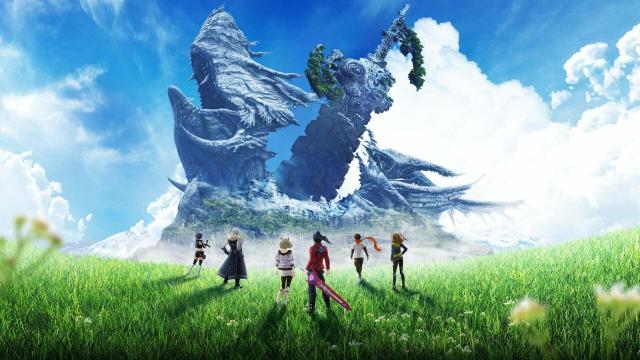All narrative-focused video games live and die on their cast of characters, and nowhere is this more true than in RPGs. Just as it’s easy to get swept up into an interesting world by the party members and supporting cast you meet along the way, it’s just as viable to realise the characters in the game are a burden or worse, deeply uninteresting. Fortunately, the teens who make up the party of Monolith Soft’s recently released JRPG Xenoblade Chronicles 3 are great.
Xenoblade Chronicles 3 is set in the world of Aionios as the kingdoms of Agnus and Keves have been locked in a years-long war. On both sides, soldiers are vat-grown and given a ten-year lifespan, during which they train and before going right into battle. Soldiers killed on the battlefield have their essence absorbed into the other faction’s giant mecha, who are powered by a device called a Flame Clock. If a Flame Clock runs out or gets destroyed, then the soldiers associated with it will instantly die, and that subsequent energy goes into the other faction’s mech. From there, the game opens on a trio of Kevesi soldiers: Noah, who plays his flute to help fallen soldiers move on to the next life, medic Eunnie, and defender Lanz.

Regardless of genre, it can be very easy for video games to get teenage or young adult characters wrong. Making teen characters feel authentic is something the medium — much like Hollywood or television — can struggle with, even with the best of intentions. That’s not the case in Xenoblade 3. The game opens with Noah’s group, and they’re compelling right from the start. Before the game has its occasionally overly long flashback cutscenes, you can tell that the trio’s time together has been just as full of loss as it has been ensuring one another survives their battles. They bicker and listen to one another like they’ve known each other for years, and the game succeeds in making you feel like you’re there with them.
Within an hour or two, the game’s plot kicks in when Noah, Lanz, and Eunnie cross paths with Agnus specialists Mio, Sena, and Taion. After fighting each other and then teaming up to fight a mech monster, the teens find that specific pairings of their group can fuse to become different mechs, and all six of them are freed from their respective Flame Clocks. Now removed from the literal biological clocks that help dictate their lives, the teens find themselves forced to stick together.

More than the combat or the bigness of the world, the banter between the party is what’s made Xenoblade Chronicles 3 so enjoyable across my current 16 hour, three-chapter playtime. The teens are just fun in the way that anime typically excels at. For every moment that they’re cool in player-controller combat or a cutscene, there’s another moment where you’re reminded of how young they literally and figuratively are. Combined with the curiosity they share about their new lease on life and the larger world around them, they become endearing pretty quickly. Noah and Mio are clearly billed as the game’s protagonists, and I do like them, but it’s Sena, Taion, Lanz, and Eunnie that have my heart.
Unity and “friendship is magic” are well worn tropes at this point, especially in anime, but I will damned if that doesn’t still work on me. The cutscenes where the teens first fuse into their mech forms — Noah and Mio get it early on, followed a chapter later by Lanz and Sena in one form and Eunnie in Taion in the other — feel earned, and in gameplay, it can be incredibly satisfying to watch AI-controlled party members fuse of their own volition. When an AI-controlled “Hero” character bestows their class to a particular party member after a specific side mission, it can be fun trying to figure out who’s going to be The One, and it’s satisfying when it’s eventually revealed who that special someone is.
One of my favourite games of 2021 was Bandai Namco’s Scarlet Nexus, an anime action-RPG that also featured a cast of soldiers forced to band together in the midst of a war. Both it and Xenoblade 3 place an emphasis on making the characters connect to each other both on a narrative and gameplay level, with Nexus relying on gift giving and visual novel-style sequences where the cast would hang out or fight together. Xenoblade 3’s approach to bonds is a little more literal, and doesn’t allow you to cheat its systems like Nexus did. At campsites, you can watch the cast sit together and eat, or have them train to get stronger. When finding the bodies of fallen soldiers in the open world, Noah or Mio can play their flutes to send those soldiers off to the next life, and occasionally, they’ll play their respective melodies together.

At all times, it feels like the teens are on the path to becoming friends, if they already aren’t already. So strong are the vibes that even the recycled dialogue lines in combat and the open world continue to have a certain charm to them. (That’s right, Sena, you are the girl with the gall.) The game isn’t subtle about its ambitions, but considering the pretty messed up world these teens live in, it’s nice that the game reinforces how hopeful they are and want to be about their situation.
Given how long Xenoblade Chronicles 3 is said to be, I know that I’ll feel that length at some point or another. So it’s a good thing I’m spending it all with such a great cast of characters who are worth being around.
Xenoblade Chronicles 3 is available now for the Nintendo Switch.

Leave a Reply